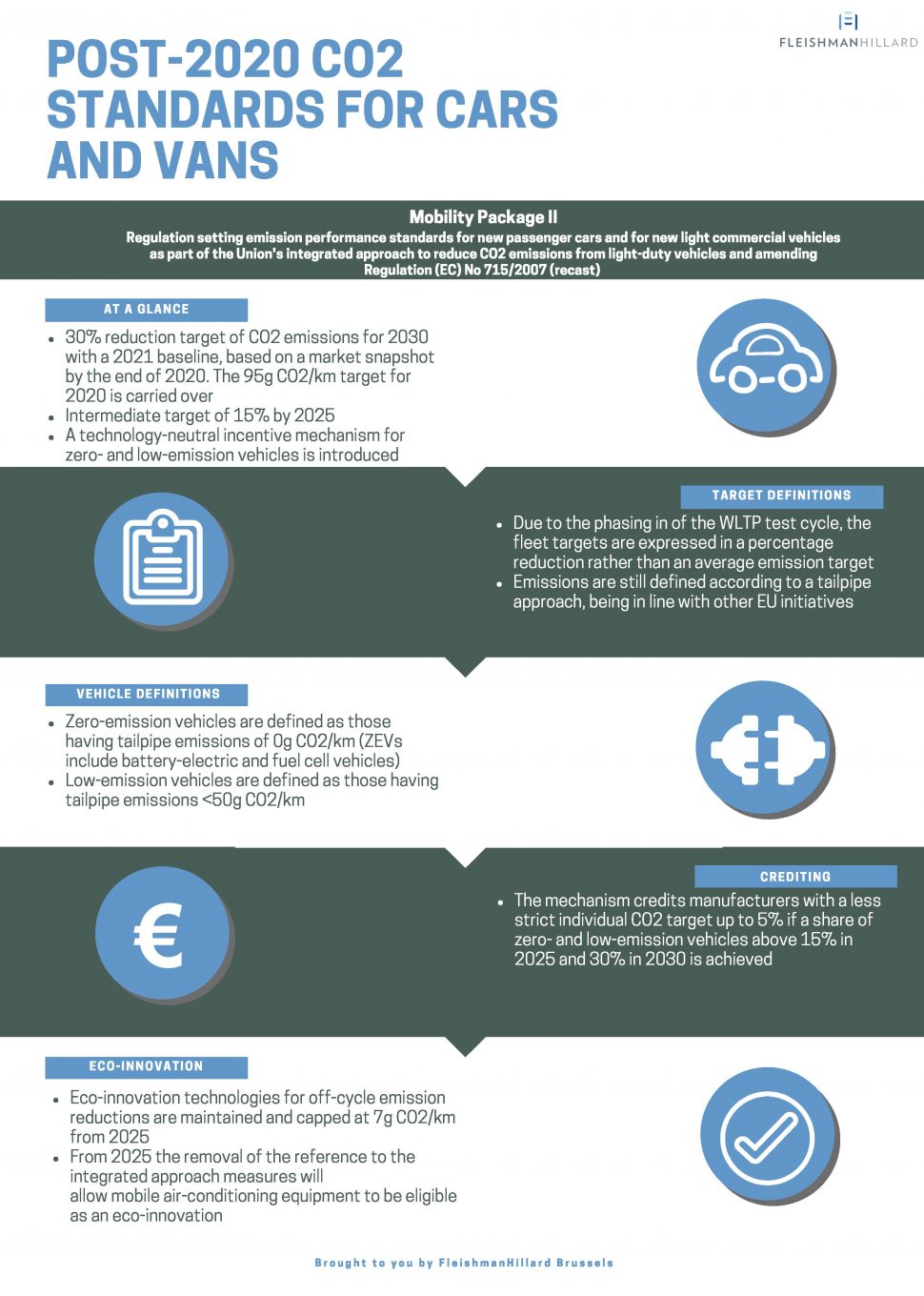Act Two: the Clean Mobility Package
Last week, we presented our view on the first Mobility Package and analysed the effects of the proposals on Member States and the EU Single Market. About as significant and contentious is the recently published ‘Clean Mobility Package’, the second phase of the overarching Strategy for Low-Emission Mobility also known as the second Mobility Package. Its aim is to help accelerate the transition to low- and zero emissions vehicles, through:
- A new target for the EU fleet wide average CO2 emissions of new passenger cars and vans of 30% by 2030 to provide stability and long-term direction;
- A 2025 intermediary target of 15% to ensure that investments kick-start already now;
- A system to encourage innovation by crediting manufacturers with a less strict individual CO2 target up to 5% if a share of zero- and low-emission vehicles above 15% in 2025 and 30% in 2030 is achieved;
- Eco-innovation measure for off-cycle emission reductions maintained and capped at 7g CO2/km from 2025.
More details can be found in the infographic below, and in this link.
An important change compared to previous targets is that this time, due to the phasing in of the WLTP test cycle, the fleet targets are expressed in a percentage reduction rather than an average emission target. The average emissions will therefore have to be 30% lower in 2030, compared to 2021. While the 2020 target of 95g CO2/km remains in place, there will be a market snapshot at the end of 2020 to determine the WLTP fleet average, and thus the baseline for the 2025 and 2030 targets.
Mirroring existing legislation, emissions are defined according to a tailpipe rather than a well-to-wheel or even life-cycle approach, which suggests that there is such a thing as a ‘zero-emission vehicle’ (ZEV): after all, an electric vehicle has tailpipe emissions of 0g CO2/km. Both battery and fuel cell EVs will thus benefit the most from the crediting mechanism that grants OEMs with a more lenient CO2 fleet target, if they attain the benchmark market shares of 15% in 2025 and 30% in 2030.
Concerns have been raised about how to ensure the electricity EVs run on is clean, and how to inform consumers about the lifecycle emissions of a given vehicle. The industry reacted to this proposal by expressing doubts on whether the technology neutrality principle is respected, given the strong push towards electrification – the main argument being that there is no ‘one size fits all approach’. Instead, the market is best to decide which technology eventually enables the greatest CO2 emissions reduction. NGOs such as Transport & Environment, conversely, dismissed the proposal as lacking ambition, arguing that the growth in transport movements in the future will offset any reductions achieved under the new Regulation.
This discussion was long anticipated, and we can only expect things to heat up when Parliamentary and Council scrutiny starts in January 2018. Two S&D MEPs will be Rapporteurs on the file in ENVI for the main report and TRAN for the opinion, while a Greens MEP will prepare the ITRE opinion. In the Council, a general approach is not expected in the first half of the year given the broad differences in the positions of manufacturing and non-manufacturing countries. Moreover, many delegations will anticipate the German position, which is still to be determined. Striking a general approach will likely fall onto the Austrian Presidency in the 2nd half of 2018. The co-legislators will then need to hammer out an interinstitutional agreement for the draft legislation to take effect, before the end of this legislature in March 2019.
Watch this space for more views on transport emissions in the 2nd quarter of 2018, as the third Mobility Package is expected to focus on reducing the carbon footprint of heavy-duty vehicles. We are on it!
Merry Christmas and Happy New Year!
The FH Transport Team
Robert, Laura, Thomas & Mara
-

Laura has been a member of the Energy and Transport team since 2013. Laura manages a wide range of clients from small companies to large manufacturing enterprises and trade associations. She previously gained experience at the European Petroleum Industry Association (now FuelsEurope) and in the...
-

Thomas joined the FleishmanHillard Energy & Transport team in early 2017, with a primary focus on the aviation, automotive and logistics sectors. He advises his clients on stakeholder engagement and legislative advocacy and supports them in creating durable relationships with policymakers. Before joining FleishmanHillard, Thomas...
Find Out More
-
Are you fit for 2024? Communicating in a year of change
February 27, 2024



